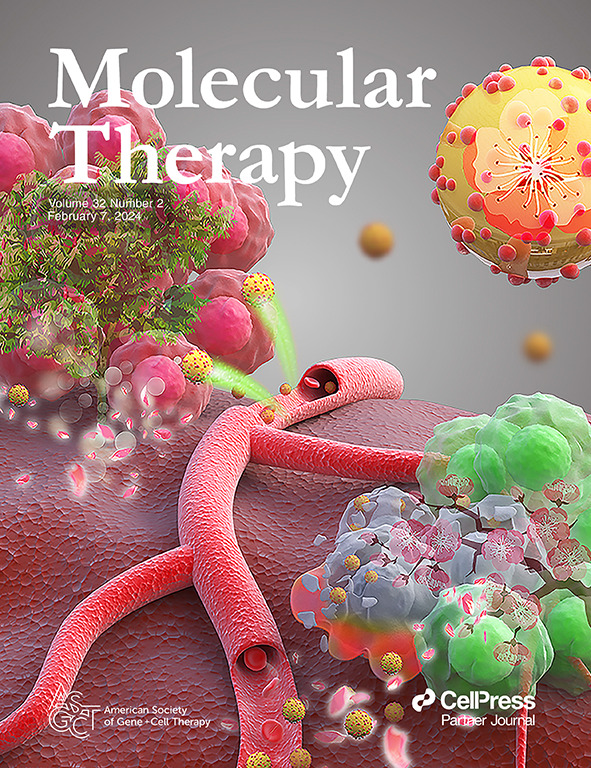肾小管上皮IGFBP7与PKM2相互作用,驱动肾脂质积累和纤维化。
IF 12.1
1区 医学
Q1 BIOTECHNOLOGY & APPLIED MICROBIOLOGY
引用次数: 0
摘要
肾纤维化是驱动慢性肾脏疾病(CKD)进展的关键病理机制。然而,这一过程的发病机制和治疗靶点尚不清楚。有趣的是,我们目前发现IGFBP7在人类患者和动物模型纤维化肾脏的小管上皮细胞(TECs)中高度表达。然而,它们在异常肾修复和肾纤维化中的功能作用尚不清楚。在这里,我们报告了IGFBP7敲除(KO)或TEC条件KO (cKO)在多种小鼠模型中减轻了肾纤维化,而IGFBP7敲入或恢复在IGFBP7-KO小鼠中增强了肾纤维化。这些体内研究结果通过培养的TECs和IGFBP7-cKO小鼠产生的类器官得到验证。在机制上,我们发现IGFBP7与丙酮酸激酶M2 (PKM2)结合,促进PKM2在K433位点的乙酰化,从而增强PKM2的二聚化和核易位,随后通过srebp1依赖机制加速脂质产生和肾纤维化。值得注意的是,通过药物筛选,我们发现沙美特罗(一种哮喘药物)是一种有效减少纤维化的IGFBP7拮抗剂。我们的研究结果揭示了IGFBP7/PKM2/SREBP1轴是脂肪性纤维化的中心调节因子,提供了IGFBP7的遗传和药理学抑制作为CKD的有希望的治疗策略。本文章由计算机程序翻译,如有差异,请以英文原文为准。
Renal tubular epithelial IGFBP7 interacts with PKM2 to drive renal lipid accumulation and fibrosis.
Renal fibrosis serves as a critical pathological mechanism driving the progression of chronic kidney disease (CKD). However, the pathogenesis and therapeutic targets involved in this process remain unclear. Interestingly, we currently found that IGFBP7 is highly expressed in tubular epithelial cells (TECs) from the fibrotic kidneys of human patients and animal models. However, their functional roles in abnormal kidney repair and renal fibrosis remain unclear. Here, we report that IGFBP7 knockout (KO) or TEC conditional KO (cKO) attenuated renal fibrosis in multiple mouse models, whereas IGFBP7 knock-in or restoration in IGFBP7-KO mice enhanced renal fibrosis. These in vivo findings were verified using cultured TECs and organoids generated from IGFBP7-cKO mice. Mechanistically, we found that IGFBP7 bound to pyruvate kinase M2 (PKM2) to promote the acetylation of PKM2 at the K433 site, thereby enhancing PKM2 dimerization and nuclear translocation, and subsequently accelerating lipid production and renal fibrosis via SREBP1-dependent mechanisms. Notably, through drug screening, we identified salmeterol (an asthma medication) as an IGFBP7 antagonist that effectively reduced fibrosis. Our findings reveal the IGFBP7/PKM2/SREBP1 axis as a central regulator of lipogenic fibrosis, offering genetic and pharmacological inhibition of IGFBP7 as promising therapeutic strategies for CKD.
求助全文
通过发布文献求助,成功后即可免费获取论文全文。
去求助
来源期刊

Molecular Therapy
医学-生物工程与应用微生物
CiteScore
19.20
自引率
3.20%
发文量
357
审稿时长
3 months
期刊介绍:
Molecular Therapy is the leading journal for research in gene transfer, vector development, stem cell manipulation, and therapeutic interventions. It covers a broad spectrum of topics including genetic and acquired disease correction, vaccine development, pre-clinical validation, safety/efficacy studies, and clinical trials. With a focus on advancing genetics, medicine, and biotechnology, Molecular Therapy publishes peer-reviewed research, reviews, and commentaries to showcase the latest advancements in the field. With an impressive impact factor of 12.4 in 2022, it continues to attract top-tier contributions.
 求助内容:
求助内容: 应助结果提醒方式:
应助结果提醒方式:


